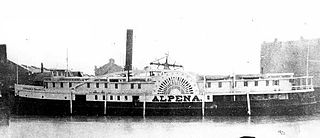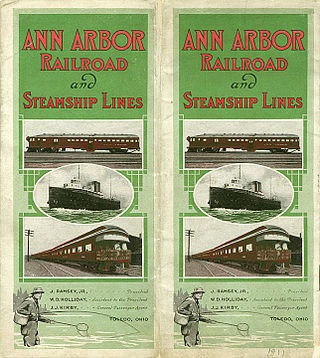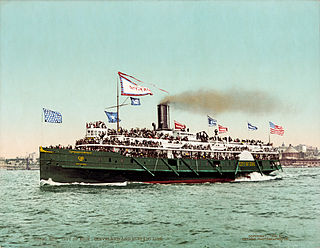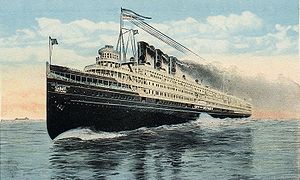
The PS Alpena was a sidewheel steamer built by Thomas Arnold of Gallagher & Company at Marine City, Michigan in 1866. She was operated by the Goodrich Line after being purchased from Gardner, Ward & Gallagher in April 1868. The Alpena sank in Lake Michigan in the "Big Blow" storm on October 15, 1880, with the loss of all on board.

The Ann Arbor Railroad was an American railroad that operated between Toledo, Ohio, and Elberta and Frankfort, Michigan with train ferry operations across Lake Michigan. In 1967 it reported 572 million net ton-miles of revenue freight, including 107 million in "lake transfer service"; that total does not include the 39-mile subsidiary Manistique and Lake Superior Railroad.

SS Columbia is the last remaining excursion steamship from the turn of the 20th century in existence, the second to last being her running mate and sister ship SS Ste. Claire which burned in 2018. Both were designed by Frank E. Kirby and Louis O. Keil, interior designer. Columbia was listed on the National Register of Historic Places in 1979, and was designated a National Historic Landmark in 1992. As of 2019, the vessel is docked at Silo City in Buffalo, New York while work is being done to rehabilitate it.

USS Sable (IX-81) was a United States Navy training ship during World War II, originally built as the passenger ship Greater Buffalo, a sidewheel excursion steamboat. She was purchased by the Navy in 1942 and converted to a training aircraft carrier to be used on the Great Lakes. She lacked a hangar deck, elevators, or armament and was not a true warship, but she provided advanced training of naval aviators in carrier takeoffs and landings.

USS Wolverine (IX-64) was a training ship used by the United States Navy during World War II. She was originally named Seeandbee and was built as a Great Lakes luxury side-wheel steamer cruise ship for the Cleveland and Buffalo Transit Company. Seeandbee was launched on 9 November 1912 and was normally used on the Cleveland, Ohio, to Buffalo, New York, route with special cruises to other ports. After the original owners went bankrupt in 1939 Seeandbee was purchased by Chicago-based C & B Transit Company and continued operating until 1941.

W. & A. Fletcher Co. was an American manufacturer of marine boilers and steam engines for steamboats on the Hudson, in the Great Lakes, Long Island Sound, and elsewhere in the late 19th and early 20th centuries. The company was founded in 1853 and associated with development of steam powered ships from the original crude efforts.
Detroit and Cleveland Navigation Company, often abbreviated as D&C, was a shipping company on the Great Lakes.

The PS Washington Irving was a 4,000-short-ton (3,600 t) sidewheel day boat and the flagship of the Hudson River Day Line that operated on the Hudson River from 1913 to 1926.

The SS Canadiana was a passenger excursion steamer that primarily operated between Buffalo, New York, US, and the Crystal Beach Park in Crystal Beach, Ontario, Canada, from 1910 to 1956. Canadiana was the last passenger vessel built in Buffalo, New York.

The Tashmoo was a sidewheeler steamboat on Lake St. Clair and Lake Huron. It was famous for being one of the fastest ships, at the time, on the Great Lakes.

The SS City of Erie was a sidewheeler steamboat on Lake Erie. It was famous for being one of the fastest ships on the Great Lakes, at the time. It also won a race against a newer, rival ship.
Frank E. Kirby was a naval architect in the Detroit, Michigan area in the early 20th century. He is widely regarded as one of the greatest naval architects in American history.
The following is a brief history of the North American rail system, mainly through major changes to Class I railroads, the largest class by operating revenue.

The Dry Dock Complex consists of six interconnected buildings located at 1801–1803 Atwater Street in Detroit, Michigan, as well as the remains of a nearby dry dock at 1900 Atwater Street. The 1801-1803 Atwater complex is also known as the Globe Trading Company Building, and in 2015 was opened by the Michigan Department of Natural Resources as the Outdoor Adventure Center.

SS Lansdowne was a railroad car ferry built in 1884 by the Wyandotte Shipyard of the Detroit Dry Dock Company. It was used as a steamer from 1884 until 1970 between Detroit, Michigan, and Windsor, Ontario, across the Detroit River. At the time of its construction it was the longest ship on the Great Lakes at 312 feet (95 m). It was a sidewheeler, and at the time of its retirement it was the last sidewheeler serving on the Great Lakes, although in 1975 the sidewheel ferry Trillium returned to active service at Toronto after many years in layup. Lansdowne was captained by Nick Saad from 1942 to 1969 until his retirement, when he was relieved by his son James Saad-Miller. Capt. Jim Miller was last to man her under her own power, when she blew the cylinder head of the port engine coming out of Detroit Slip on midnight watch in 1970. The engines were from an even older paddle steamer, Michigan, built in 1878. Lansdowne was thereafter used as a barge, pushed by a towboat, until her final retirement.

Due to its unique geography, being made of two peninsulas surrounded by the Great Lakes, Michigan has depended on many ferries for connections to transport people, vehicles and trade. The most famous modern ferries are those which carry people and goods across the Straits of Mackinac to the car-free Mackinac Island but before the Mackinac Bridge was built, large numbers of ferries carried people and cars between the two peninsulas. Other ferries continue to provide transportation to small islands and across the Detroit River to Canada. Ferries once provided transport to island parks for city dwellers. The state's only national park, Isle Royale cannot be reached by road and is normally accessed by ferry. The largest ferries in Michigan are the car ferries which cross Lake Michigan to Wisconsin. One of these, the SS Badger is one of the last remaining coal steamers on the Great Lakes and serves as a section of US Highway 10 (US 10). The Badger is also the largest ferry in Michigan, capable of carrying 600 passengers and 180 autos.

SS B.F. Jones was a steel-hulled Great Lakes freighter that was named after one of the founders of the Jones and Laughlin Steel Company. She was launched on December 30, 1905 as hull #15. She operated from April 1906 to August 21, 1955 she collided with the steamer Cason J. Callaway. After inspection she was declared a constructive total loss, and scrapped in Duluth, Minnesota.

SS Greater Detroit was a sidewheel steamer on Lake Erie that was launched in 1923. It was operated by the Detroit and Cleveland Navigation Company and carried passengers between Detroit, Michigan and Buffalo, New York. Greater Detroit and her sister ship, SS Greater Buffalo, were the largest and most expensive sidewheel steamers in the world at the time of their launching, and were capable of transporting more passengers than many oceangoing liners of the time. They were renowned for their onboard luxury, decor and modern amenities. Nicknamed the "Leviathan of the Great Lakes", Greater Detroit was in passenger service for 26 years until 1950, when she became too expensive to continue to operate. The ship was sold for scrap in 1956.


















